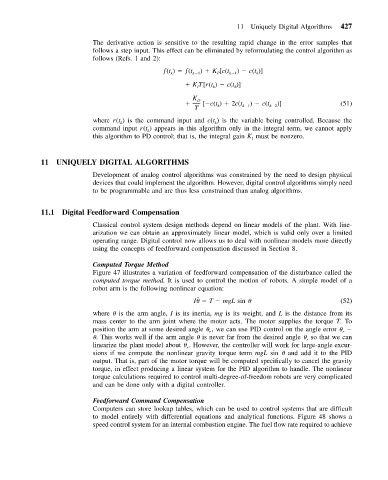Page 436 - Mechanical Engineers' Handbook (Volume 2)
P. 436
11 Uniquely Digital Algorithms 427
The derivative action is sensitive to the resulting rapid change in the error samples that
follows a step input. This effect can be eliminated by reformulating the control algorithm as
follows (Refs. 1 and 2):
ƒ(t ) ƒ(t k 1 ) K [c(t k 1 ) c(t )]
P
k
k
KT[r(t ) c(t )]
k
k
I
K D
[ c(t ) 2c(t ) c(t )] (51)
T k k 1 k 2
) is the command input and c(t ) is the variable being controlled. Because the
where r(t k k
command input r(t ) appears in this algorithm only in the integral term, we cannot apply
k
this algorithm to PD control; that is, the integral gain K must be nonzero.
I
11 UNIQUELY DIGITAL ALGORITHMS
Development of analog control algorithms was constrained by the need to design physical
devices that could implement the algorithm. However, digital control algorithms simply need
to be programmable and are thus less constrained than analog algorithms.
11.1 Digital Feedforward Compensation
Classical control system design methods depend on linear models of the plant. With line-
arization we can obtain an approximately linear model, which is valid only over a limited
operating range. Digital control now allows us to deal with nonlinear models more directly
using the concepts of feedforward compensation discussed in Section 8.
Computed Torque Method
Figure 47 illustrates a variation of feedforward compensation of the disturbance called the
computed torque method. It is used to control the motion of robots. A simple model of a
robot arm is the following nonlinear equation:
¨
I T mgL sin (52)
where is the arm angle, I is its inertia, mg is its weight, and L is the distance from its
mass center to the arm joint where the motor acts. The motor supplies the torque T.To
position the arm at some desired angle , we can use PID control on the angle error
r
r
. This works well if the arm angle is never far from the desired angle so that we can
r
linearize the plant model about . However, the controller will work for large-angle excur-
r
sions if we compute the nonlinear gravity torque term mgL sin and add it to the PID
output. That is, part of the motor torque will be computed specifically to cancel the gravity
torque, in effect producing a linear system for the PID algorithm to handle. The nonlinear
torque calculations required to control multi-degree-of-freedom robots are very complicated
and can be done only with a digital controller.
Feedforward Command Compensation
Computers can store lookup tables, which can be used to control systems that are difficult
to model entirely with differential equations and analytical functions. Figure 48 shows a
speed control system for an internal combustion engine. The fuel flow rate required to achieve

